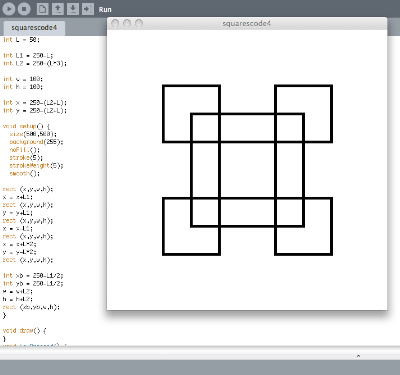Final
Structure:
This is my structured composition as you can see. I wanted to work with circles since a circle is a very symmetrical shape as it revolves around a point making it a very structured shape compared to many other shapes. So I wanted to see what I could do to distort them and transform them into noise and into something unrecognisable to a circle. I added in a stroke to the circles that is the same as the fill, but not opacified like the fill of the circles. I decided on this blue from my inspiration image of a possible colour palate. This used this bold coloured stroke to make my circles pop out from the black background and not melt into it.Structure + Little Noise:
I still kept the original layout of the repeating circles on the x and y axis, but added noise in the form of extra circles transformed by the random function to make ovals overtop the existing circles. Also if you look closely enough you can make out that although I have kept the existing layout I have also made the first layer of circles into wonky vertical and horizontal lines. Thus introducing noise into my composition.Noise + Little Structure:
I added another ellipse to the mix to create an increase in the noise of the composition. I also made the random function for the last layer have a wider variation in the sizing of the ellipses. After I had done that it didn't seem like enough change had happened so I increased the wonkyness and the random function to change the variation in the widths and heights of the first layer. And this was the result. This I thought was a good composition for the second to last image as it showed more the noise of the ellipses but still a little but of structure was left in the composition (but not much).Noise:
Finally there was no more structure left and all that is present are the curved lines of the ellipse overlapping each other left due to increasing the variation in sizing and layout (wonkyness). The composition that I had stated with is no longer present at all which is what I wanted to achieve. The overlapping ellipses that are all opacified down creates an aesthetically pleasing composition due the different variations of blue that the layering has caused. Also the thin stroke enhances the aesthetics to create a messy yet artistic look about it. This is so contrasted against the boring structured look of the first composition.Final Assembly of all 4 Compositions:
In the assembly of all four compositions you can notice the transformation taking place from a very structured composed image to a very loud and noisy composition. Along with this transformation you can see a gradual inclination of a gradient taking place. To make my transformation effective I made my structured image very unoriginal where all you notice are the neatly formed rows of circles seems void of expression and is very organised whereas in the noisy image you can see that the ellipses have become disorganised, multiplied and grown into a composition full of expression and emotion to create a uniquely-vivid noisy composition. I am very pleased with my outcome and now can now understand the coding for looping a lot better than I did at the start where I was pretty much lost.



















































